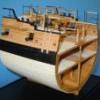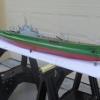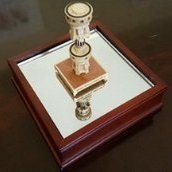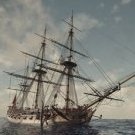Supplies of the Ship Modeler's Handbook are running out. Get your copy NOW before they are gone! Click on photo to order.
×
-
Posts
2,420 -
Joined
-
Last visited
Reputation Activity
-
 dvm27 got a reaction from Piet in Young America 1853 by EdT - FINISHED - extreme clipper
dvm27 got a reaction from Piet in Young America 1853 by EdT - FINISHED - extreme clipper
That jig is a keeper, Ed. Good stuff!
-
 dvm27 got a reaction from md1400cs in Young America 1853 by EdT - FINISHED - extreme clipper
dvm27 got a reaction from md1400cs in Young America 1853 by EdT - FINISHED - extreme clipper
That jig is a keeper, Ed. Good stuff!
-
 dvm27 reacted to EdT in Young America 1853 by EdT - FINISHED - extreme clipper
dvm27 reacted to EdT in Young America 1853 by EdT - FINISHED - extreme clipper
Young America - extreme clipper 1853
Part 206 – Lower Shrouds
The two gangs of lower fore shrouds were made in the last part and were ready for the deadeyes to be turned in. I used the fixture shown in the first picture to position the shrouds at a uniform height and to hold things in place for putting on the seizings.
The fixture is made from a thin (1/32") sheet of hardwood. It is drilled to allow the two lower lanyard holes in each deadeye to be threaded with wire to hold the parts in place. Wire at the bottom of the fixture is used to anchor the fixture to the channel deadeye straps as shown below.
In the picture the first shroud pair on the port side has been seated over the first starboard pair, not shown, at the mast head. Those two opposite shrouds were secured first. The next picture shows the first port shroud wrapped around its deadeye and the throat seizing being put on.
The short end of this shroud will be forward on this (port) side – aft on the other side. Some will no doubt observe that this is opposite the orientation on ships with cable-laid, i.e. left-handed, shrouds of the type used in, for example, the Royal Navy. I might also note that looping the short end forward and in front of the standing shroud is the way the rope would naturally loop if twisted "with the lay" – another opposite with right-handed rope. Twisting in this direction helped keep water out. Stay tuned. There is more of this minutiae later.
This first served shroud is the most difficult to fit due to its stiffness. The next picture shows frapping turns being placed on the second seizing using a needle.
Alligator clips are most useful in holding rigging. They are light, small, and grip tightly. Note that some of my serving is unravelling in the picture because I cut it prematurely – before applying some glue. The next picture shows the gang of six lower shrouds on the starboard side.
The excess seizing threads have been clipped off and the rope ends, as well as the seizings, have been wetted with darkened glue. The port side work is still in progress. In the next picture, both fixtures have been detached from the channels and the lanyard has been reeved on the #1 shroud on the starboard side.
The lanyard is 5¼" rope, laid up from three strands of No. 60 linen thread and dyed with walnut extract stain. The excess lanyard will be wound over the shroud and seized after all twelve shrouds are finally tensioned and the sheer poles lashed on.
Next time.
Ed
-
 dvm27 reacted to michael mott in Bristol Pilot Cutter by michael mott - 1/8 scale - POF
dvm27 reacted to michael mott in Bristol Pilot Cutter by michael mott - 1/8 scale - POF
Well thanks to everyone who have pressed the like button on this rather slow build.
I took a break from all the other stuff today and did a bit more reworking of the cabin I am still working out the shape and size of the companionway into the hull.
The underside of the forward section of the cut up cabin was a bit weak and so I added a thin reinforcing strip to keep things together until the rear cross timber is added
I shortened the rails and the hatch and also cut the rear section of the old cabin top in half along the line of the front of the new structure (temporary blocked up to see if this shape and size feel right)
So I will sit with this for a couple of days and then if it still feels about right I will finish up the structure and it will be fixed permanently with the rear section to the deck. Access to the interior will still be adequate through the two forward sections in order to load and unload the ballast weights.
Michael
-
 dvm27 reacted to Kurt Johnson in HMS Pegasus by Blue Ensign - FINISHED - Amati/Victory Models - 1:64 scale
dvm27 reacted to Kurt Johnson in HMS Pegasus by Blue Ensign - FINISHED - Amati/Victory Models - 1:64 scale
BE,
I've always wanted to build one off the classic steam launches, like the one above. I love that wood work!! That would be a nice project.
Kurt
-
 dvm27 reacted to marsalv in Pandora by marsalv - FINISHED - 1:52
dvm27 reacted to marsalv in Pandora by marsalv - FINISHED - 1:52
Thank you guys,
the galley stove is ready, it remains only to finish a few details and make the blackening.
-
 dvm27 reacted to Drazen in De Zeven Provinciën 1665 by Dražen - Scale 1:45
dvm27 reacted to Drazen in De Zeven Provinciën 1665 by Dražen - Scale 1:45
Now, a fine work has to be done - same as for the sternpost, the stem and later the keel shall fit nicely to the planking.
It is a arduous process with making the slots (on the real ship - a rabbet), not to over-grind and at the same time checking the fit to the hull/planks, checking the starboard and the portside of the ship … than over and over again the multiple-iteration-process … till both sides of the ship, all whales and the planks fit as they should.
Still, I find this method much easier and more exact (optically) as to make first a rabbet and insert the planks into the rabbet – without a clear/clean possibility to grind the planks smooth afterwards.
The photos were made as the fitting was not yet nice – I am still working on it.
Drazen
-
 dvm27 reacted to Drazen in De Zeven Provinciën 1665 by Dražen - Scale 1:45
dvm27 reacted to Drazen in De Zeven Provinciën 1665 by Dražen - Scale 1:45
Here are just some tools I used to bring the hull surface in shape. The relatively big orbital sander (red appliance) made a good job - it smoothes all edges of the planks perfectly and makes the work fast (with taking care not to overdo or even not to work with it on critical places, like edges of stern or rabbet at the stern post.
Drazen
-
 dvm27 reacted to Blue Ensign in HMS Pegasus by Blue Ensign - FINISHED - Amati/Victory Models - 1:64 scale
dvm27 reacted to Blue Ensign in HMS Pegasus by Blue Ensign - FINISHED - Amati/Victory Models - 1:64 scale
Making a Base for Pegasus
The cradles are cut from some 1/8th Boxwood sheet stuff having used the kit stand as a template.
For this the beast has to come out.
Two lengths of 12mm square walnut are slotted to take the cradles.
The little miller is very handy for this.
The basic cradles completed.
My preferred option is for a base where the model sits on stylised Keel Blocks supported by cradles of the minimum profile sufficient to give the model stability.
The Bohler makes quick work of cutting the keel blocks from 12mm section Walnut, which will be topped by 9mm section blocks on which the keel will sit.
This is not the proper base, just an old drawer front used for the purpose of setting out.
The model sits on a plain oak base which will be contained within a protective acrylic case.
Setting out the keel blocks.
The base completed.
I now need to have the protective case made.
This is not unsubstantial being 780mm long x 640mm high x 330mm wide.
In the meantime I will continue to fuss over the model tweaking and cleaning.
B.E.
-
 dvm27 reacted to guraus in Machine a curer les ports 1750 by guraus (Alexandru) - FINISHED - 1/36
dvm27 reacted to guraus in Machine a curer les ports 1750 by guraus (Alexandru) - FINISHED - 1/36
Thank you Greg, Druxey, Christian and Albert.
I made some progress in the couple last weeks and now the barge is completed. The inside was already oiled as once the deck is in place I will have limited access to do it later - even if the deck planking is only partial.
Here are the pictures.
Alexandru
-
 dvm27 reacted to guraus in Machine a curer les ports 1750 by guraus (Alexandru) - FINISHED - 1/36
dvm27 reacted to guraus in Machine a curer les ports 1750 by guraus (Alexandru) - FINISHED - 1/36
Hello,
The deck framing is now complete. Here are some pictures.
Alexandru
-
 dvm27 reacted to Mike Y in Beavers Prize 1777 by Mike Y - 1:48 - POF - Hahn style
dvm27 reacted to Mike Y in Beavers Prize 1777 by Mike Y - 1:48 - POF - Hahn style
Still procrastinating, spending modelling time on things like handmade gifts to close family And when not - playing with tools.
Built a crosscut and miter sled for the Proxxon FET saw.
They are more precise and safer than the miter guide on the saw. Helping to keep fingers further from the blade and have a quick and consistent 90deg and 45deg angles.
-
 dvm27 reacted to KeithAug in Altair 1931 by KeithAug - FINISHED - Scale 1:32 - schooner
dvm27 reacted to KeithAug in Altair 1931 by KeithAug - FINISHED - Scale 1:32 - schooner
Thank you John.
I had been looking forward to a change from doing cleats so I had a go at a bit of detail that I had been looking forward to.
The main sheet has 3 attachments to the deck, a single pulley port and starboard and a central double pulley attached to the deck via quite an elaborate shock absorber. Its this latter feature that I decided to attempt next. The sketch shows the detail.
The shock absorber has 2 compression springs which close when load is transmitted from the central main sheet block via the floating collars. I thought it would be kind of nice to make a working version. The whole thing is a little over and inch wide and .250 high.
The 2 deck fixings were turned from bar and drilled on the mill. I ground a couple of profile lathe tools to assist the task.
The floating collars were also turned on the lathe and drilled on the mill. I used the same profile tool that I had used for the balls on the deck fixings. The shaft is .060 wire.
The spring was the most difficult bit. I spent ages ferreting through my rainy day boxes until I found something that I could butcher.
The floating collars are attached to the block shackle by 2 large U shaped connecting brackets. The brackets pivot on pins protruding from either side of each collar.
Nuts on each end of the shaft complete the assembly.
Once again the plans are not great and show the shock absorber mounted in the wrong position. The internet saved the day.
-
 dvm27 got a reaction from Nirvana in Altair 1931 by KeithAug - FINISHED - Scale 1:32 - schooner
dvm27 got a reaction from Nirvana in Altair 1931 by KeithAug - FINISHED - Scale 1:32 - schooner
Been very close to step 4, Keith! Definitely optional.
-
 dvm27 got a reaction from mtaylor in Altair 1931 by KeithAug - FINISHED - Scale 1:32 - schooner
dvm27 got a reaction from mtaylor in Altair 1931 by KeithAug - FINISHED - Scale 1:32 - schooner
Been very close to step 4, Keith! Definitely optional.
-
 dvm27 got a reaction from mtaylor in Altair 1931 by KeithAug - FINISHED - Scale 1:32 - schooner
dvm27 got a reaction from mtaylor in Altair 1931 by KeithAug - FINISHED - Scale 1:32 - schooner
Beautiful work, Keith. It seems like backlash is a problem for me when I try to do repeated sequences such as you have done above. I found an article by Sherline on how to adjust for it and I shall have to read it.
-
 dvm27 got a reaction from mtaylor in Yet Another Pandora 3D build
dvm27 got a reaction from mtaylor in Yet Another Pandora 3D build
There are several books which depict the shipyard but here's a photo of a completed ship in it's slipway with launching cradle
http://collections.rmg.co.uk/collections/objects/66473.html
-
 dvm27 reacted to Erik W in HM Cutter Cheerful 1806 by Erik W - 1:48 scale
dvm27 reacted to Erik W in HM Cutter Cheerful 1806 by Erik W - 1:48 scale
I finished planking the hull. Woohoo! Feels kind of weird to not be adding a plank or two after work every day. I also added the stern post, and did a more thorough sanding of the planking on both sides of the lower hull, paying close attention to getting rid of any high and low spots. I still need to do more work where the planking meets the keel and the stem. Also, the black paint on the wale has taken quite a beating. I'll fix that later. I was hesitant to include the bow shot, since the planks on either side don't line up at the stem too well. Figured it was still an interesting angle for a photo though.
Erik
-

-
 dvm27 reacted to Gaetan Bordeleau in 74-gun ship by Gaetan Bordeleau - 1:24
dvm27 reacted to Gaetan Bordeleau in 74-gun ship by Gaetan Bordeleau - 1:24
Thank you Rob,
Frames assembly on the keel is made in 3 stages: middle, front and back
Mainly to cut the notches in the frames for the assembly
Before doing front and back keel tapering must be done
-
 dvm27 reacted to shipmodel in Raleigh 1777 by KennyH78 - Scale 1:96 - Continental Frigate - Hahn Plans
dvm27 reacted to shipmodel in Raleigh 1777 by KennyH78 - Scale 1:96 - Continental Frigate - Hahn Plans
Hi Kenny -
Nice clean work on the backbone.
Before you start adding frames, let me suggest that you do all of the shaping of these pieces that you can. It is so much easier to do this without the frames getting in the way.
For example, the width of the keel tapers towards the stern, and the stern post tapers from top to bottom, making the extreme heel of the hull the second narrowest spot. (You may have done this already, but I could not tell in the photos.) The narrowest spot is the heel of the deadwood, which also tapers from fore to aft and top to bottom, and is thinner than the sternpost by twice the thickness of the planking. To get the planks to run smoothly against the sternpost the rabbet has to be wide and shallow. I do not know your plans, but there is often a dotted, curved line called the 'bearding line' which indicates the width of the rabbet. This width changes all along the length of the backbone and up the stem as the shape of the hull changes how the planks angle into the rabbet. The shallower the angle of attack, the wider the rabbet has to be.
Let me also suggest that you cut the rabbet a little deeper than you think you need. It always surprises me when the planks want to ride higher than planned, and then they have to be planed or sanded to shape. Sometimes they ride so high that I have to go back and deepen the rabbet or I would have to sand right through the plank, all the while trying not to ruin parts and planks already installed. Better to make it deeper than needed, which can be filled with putty or even glue as the planking is installed.
Best of success
Dan
-
 dvm27 reacted to KennyH78 in Raleigh 1777 by KennyH78 - Scale 1:96 - Continental Frigate - Hahn Plans
dvm27 reacted to KennyH78 in Raleigh 1777 by KennyH78 - Scale 1:96 - Continental Frigate - Hahn Plans
Before cutting any of the frames, I decided to make the backbone. It is now complete, I was terrified when it was time to cut the rabbet, but a V-gauge chisel made it easy. It's not perfect, but I'm happy with it. So without further ado, here are the pictures. Tomorrow I start cutting frames and I'm hoping I don't screw any of them up, but I am expecting to have to remake at least a few of them.
-
 dvm27 got a reaction from herask in Yet Another Pandora 3D build
dvm27 got a reaction from herask in Yet Another Pandora 3D build
There are several books which depict the shipyard but here's a photo of a completed ship in it's slipway with launching cradle
http://collections.rmg.co.uk/collections/objects/66473.html
-
 dvm27 reacted to michael mott in Albertic by michael mott - FINISHED - Scale 1:100 - RESTORATION - Bassett-Lowke Model
dvm27 reacted to michael mott in Albertic by michael mott - FINISHED - Scale 1:100 - RESTORATION - Bassett-Lowke Model
Nils thanks and thanks to everyone who has quietly visited, it is encouraging to know that the work is being followed.
The next tackle was the next most damaged davit it was quite well bent in a couple of spots.
The winder was badly bent and the frame twisted with the solder joint fractured, this was not going to be able to be fixed as a single element so I decided to take it apart. the first task was to drill out the riveted end of the arm where it joins the frame.
Using one of the small toolmakers clamps set up in the small vice on the drill I was able to drill enough of the riveted head away to remove it still leaving enough to reassemble it later.
The frame assembly now needed to be taken apart in order to extract the bend shaft.
Using the air soldering gun and capturing the frame in the small steel clamp in the third hand the one end fell away easily
slipping the long part of the shaft into a pin vise enable me to bend the handle end back in line with some fine needle nose pliers.
the frame part that was still bent now needed to be straightened so that it could be mated back to the rest of the frame, this was done again with a couple of pairs of needle nosed pliers using them as miniature vises.
next the unit needed to be re soldered together I used Duzall flux and a flake of soft solder
the hot air gun was used to re-solder the joint.
I have cleaned and repainted it and put it back together and now it is looking new and old again.
Michael
-
 dvm27 reacted to KeithAug in Altair 1931 by KeithAug - FINISHED - Scale 1:32 - schooner
dvm27 reacted to KeithAug in Altair 1931 by KeithAug - FINISHED - Scale 1:32 - schooner
Arrrrrrrgh!
Today was one of those "Damn and Blast" days.
I was investigating the web to make sure that I got the positioning of the 4 secondary winches (omitted from the plans) in the correct position. One side effect of the investigation is that I found 4 cleats (2 deck mounted and 2 bulwark mounted) that were also omitted from the plans. I didn't have enough spare components so it was back to a production run. Also I had been mithering about the bulwark cleats being a tad too large and I hadn't really done a detailed job on the mounting plate. The need to set up the production line once more prompted me to rip off the existing bulwark cleats and replace them.
The bulwark cleats have a single central mounting point with the foot being attached to the bulwark frames. The feet are quite small.
The results of a full days production - the .750" pin is included for scale:-
I glued the feet to the frames before passing the cleat mounting pin through the hole.
I think I now have the right number cleats and winches on the rear deck - only time will tell!!







